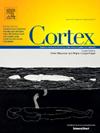帕金森病患者句子加工和口腔运动过程中皮质纹状体通路有效连接的改变
IF 3.3
2区 心理学
Q1 BEHAVIORAL SCIENCES
引用次数: 0
摘要
先前的研究表明,患有帕金森病(PD)的人的句子处理能力可能受损。然而,PD患者语言障碍背后的神经机制是否与运动症状相似,是否与皮质纹状体通路的功能障碍有关尚不清楚。另一方面,创伤性脑损伤(TBI)被认为是日后患PD的重要非遗传风险因素。本研究探讨了皮质纹状体通路的功能变化对PD患者句子理解和口腔运动功能的影响。它比较了有TBI病史的PD患者和没有TBI病史的PD患者。24名PD患者(12名有TBI, 12名没有TBI)和12名年龄和性别匹配的对照组接受了功能MRI (fMRI)和动态因果模型。这些评估旨在评估句子理解和口头运动任务期间的大脑活动和有效连接。PD患者在激活的脑区和皮质纹状体通路内的有效连接中观察到显著的中断(p <;. 05)。与没有创伤性脑损伤的人相比,那些患有创伤性脑损伤的人在典型句子理解过程中表现出了不同的大脑活动。无脑外伤的PD组在口腔运动任务中表现出更大的皮质-皮质区和皮质-皮质下区之间的双向连通性(p <;. 05)。这些发现表明,运动和语言网络有效连接的减少可能导致PD患者的语言和运动障碍。利用功能磁共振成像(fMRI)来评估激活的大脑区域以及运动和语言网络之间的有效连接,可能有助于识别未来患帕金森病风险较高的TBI患者。本文章由计算机程序翻译,如有差异,请以英文原文为准。
Altered effective connectivity in cortico-striatal pathways during sentence processing and oral motors in Parkinson’s disease
Previous studies have demonstrated that sentence processing can be impaired in individuals with Parkinson’s disease (PD). However, it remains unclear whether the neural mechanisms underlying language impairments in PD are like the motor symptoms and related to dysfunction observed in cortico-striatal pathways. On the other hand, traumatic brain injury (TBI) is recognized as a significant non-genetic risk factor for developing PD later in life. This study investigated the functional changes in cortico-striatal pathways that impact sentence comprehension and oral motor functions in individuals with PD. It compared PD patients with a history of TBI to those without. Twenty-four PD patients (12 with and 12 without TBI) along with 12 age- and sex-matched controls, underwent functional MRI (fMRI) and dynamic causal modeling. These assessments aimed to evaluate brain activity and effective connectivity during sentence comprehension and oral motor tasks. Significant disruptions were observed in both activated brain regions and effective connectivity within cortico-striatal pathways in PD patients (p < .05). Those with TBI exhibited altered brain activity during canonical sentence comprehension when compared to those without TBI. The PD group without TBI displayed greater bidirectional connectivity between cortico-cortical and cortico-subcortical areas during oral motor tasks (p < .05). These findings suggest that reduced effective connectivity in motor and language networks may contribute to language and motor impairments in individuals with PD. Utilizing fMRI to evaluate activated brain regions and effective connectivity within motor and language networks may help identify TBI patients who are at a higher risk of developing PD in the future.
求助全文
通过发布文献求助,成功后即可免费获取论文全文。
去求助
来源期刊

Cortex
医学-行为科学
CiteScore
7.00
自引率
5.60%
发文量
250
审稿时长
74 days
期刊介绍:
CORTEX is an international journal devoted to the study of cognition and of the relationship between the nervous system and mental processes, particularly as these are reflected in the behaviour of patients with acquired brain lesions, normal volunteers, children with typical and atypical development, and in the activation of brain regions and systems as recorded by functional neuroimaging techniques. It was founded in 1964 by Ennio De Renzi.
 求助内容:
求助内容: 应助结果提醒方式:
应助结果提醒方式:


